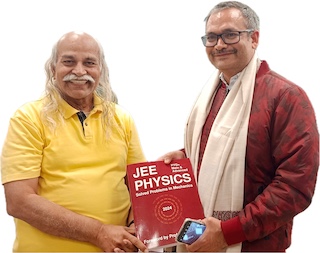Alternating Current (AC)
An AC voltage varies with time $t$ as \begin{align} V(t)=V_0\sin\omega t, \end{align} where $V_0$ is the peak (or maximum or amplitude) voltage and $\omega$ is the angular frequency. The angular frequency is related to the frequency $\nu$ and the time period $T$ by \begin{align} \omega=2\pi\nu=\frac{2\pi}{T}. \end{align}
RMS and Peak Values
It is important to understand the concepts related to AC. All of us know about power supply in our home. It is AC. Its voltage is 220 V. Its frequency is 50 Hz. If we measure the voltage (actually potential difference) by connecting a voltmeter to a plug point, it displays 220 V. This is the RMS (Root Mean Square) value i.e., $V_\text{rms}=220$ V.
Measuring or visualising frequency is not so easy. The voltage changes its polarity 50 times in a second i.e., one cycle in 0.02 s. The current changes its direction 50 times in a second. An oscilloscope is used to measure the frequency and display how voltage changes with time. If you connect an oscilloscope to a plug point in your home, its display will look like the following figure:
The voltage $V$ varies with time $t$ in a wave-like pattern. The voltage is zero at time $t=0$, reaches a maximum value of 311 V at $t=0.005$ s, then decreases to zero at $t=0.01$ s, hereafter it changes sign, attains a value of $-311$ V at $t=0.015$ s, and finally complete the cycle by attaining zero at $t=0.02$ s. The waveform is sinusoidal. Its frequency is defined as the inverse of time taken to complete one cycle i.e., \begin{align} \nu=\frac{1}{0.02}=50\,\mathrm{Hz}. \nonumber \end{align}
The amplitude (or peak value or maximum value) of voltage is 311 V i.e., $V_0=311$ V. The amplitude $V_0$ and frequency $\nu$ are used to express voltage as a function of time as \begin{align} V=V_0\sin(2\pi \nu t) = 311\sin(100\pi t). \nonumber \end{align} Thus, voltage is completely defined by its frequency and amplitude. RMS is a useful mathematical construct given by \begin{align} V_\text{rms}=\frac{V_0}{\sqrt{2}}. \nonumber \end{align} RMS and amplitude are related by the above relation. One of them is good enough to specify the AC voltage. While specifying AC voltage, it is a good practice to mention whether specified value is the amplitude or the RMS value e.g., we should say "the RMS value of voltage supply in our home is 220 V". If not mentioned specifically, convention is to assume it as a RMS value.
Above concept is also true for alternating current.
AC Source Connected to Resistor
When an AC source, $V=V_0\sin\omega t$, is connected to a resistor R, a current flows through it. The current in the circuit is given by \begin{align} i &=\frac{V}{R} \\ &=\frac{V_0}{R}\sin\omega t. \\ &=i_0\sin\omega t. \end{align} The current is in phase with the source voltage. The average current (or average voltage) over complete cycle is zero.
The instantaneous power dissipated in the resistor is \begin{align} p=i^2 R=i_0^2R\sin^2\omega t. \end{align} The average power over a complete cycle is \begin{align} \bar{p} & =\frac{\int_0^T p\mathrm{d}t}{T} \\ &=\frac{1}{2}i_0^2 R \\ &=i_\text{rms}^2 R\\ &=\frac{V_\text{rms}^2}{R}\\ &=I_\text{rms}V_\text{rms} \end{align} where the rms (root mean square) current and rms voltage are defined as \begin{align} i_\text{rms}&=i_0/\sqrt{2}=0.707i_0 \\ V_\text{rms}&=V_0/\sqrt{2}=0.707V_0. \end{align}
AC Source Connected to Inductor
When an AC source is connected to an inductor, the inductor will store energy in a magnetic field as the current flows through it. The behavior of the inductor is determined by its inductance L and the angular frequency $\omega$ of the AC source.
The behavior of an inductor is described by its inductive reactance $X_L=\omega L$. At low frequencies, the inductor will appear as a short circuit, allowing the maximum flow of current. At high frequencies, the inductor will act as a maximum impedance, effectively blocking the flow of current.
The voltage across and the current through the inductor are given by \begin{align} V&=V_0\sin\omega t \\ i&=\frac{V_0}{\omega L}\sin\left(\omega t-\frac{\pi}{2}\right) \end{align} The inductive reactance $X_L=\omega L$ determines the peak current \begin{align} i_0=\frac{V_0}{X_L}=\frac{V_0}{\omega L}. \end{align}
The voltage across the inductor leads the current by $\phi=\pi/2$. The average power supplied to an inductor over one complete cycle is zero.
AC Source Connected to Capacitor
When an AC source is connected to a capacitor, the capacitor will store energy in an electric field as the current flows through it. The behavior of the capacitor is determined by its capacitance C and the angular frequency $\omega$ of the AC source.
The behavior of a capacitor is described by its capacitive reactance $X_C=1/\omega C$. At low frequencies, the capacitor will appear as an open circuit, effectively blocking the flow of current. At high frequencies, the capacitor will appear as a short circuit, effectively allowing the maximum flow of current.
The voltage across the capacitor when it has a charge $q$ is given by $V_C=q/C$. The voltage across and the current through the capacitor are given by \begin{align} V&=V_0\sin\omega t \\ i&=\frac{V_0}{1/\omega C}\sin\left(\omega t+\frac{\pi}{2}\right) \end{align} The capacitive reactance $X_C=1/\omega C$ determines the peak current \begin{align} i_0=\frac{V_0}{X_C}=V_0 \omega C. \end{align}
The voltage across the capacitor lags the current through it by $\phi=\pi/2$. The average power supplied to an inductor over one complete cycle is zero.
